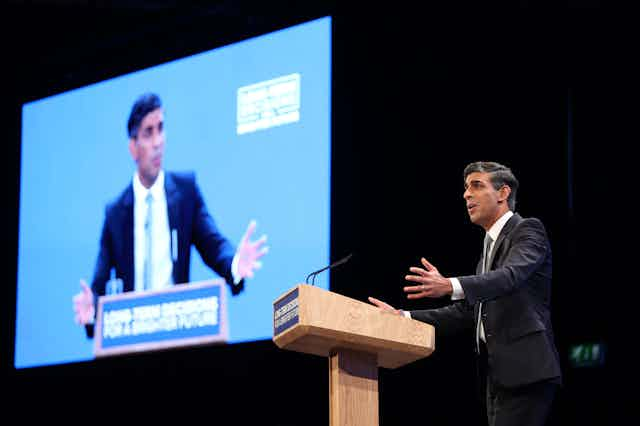The party conference speech is traditionally an important moment for political leaders. It enables them to set the agenda, rally the core membership and supporters around key themes, and speak to the wider audience of electors.
The Conservative party has now had five different party leaders giving conference speeches as prime minister at this time of year since 2015. This is the third party leader to give a speech in the past three years.
Rishi Sunak’s first party leader speech may indeed be his only one if the election is called before October 2024 and he is removed from office and the leadership.
Having lost the 2022 party leadership contest to Liz Truss, then, after her brief tenure, becoming party leader and prime minister without any further general or party leader election, Sunak has no electoral mandate to draw on.
With a general election within a year, the party conference speech offers the opportunity to set out a narrative and present personal credentials to party and the electorate. Takeover prime ministers do, however, struggle to build electoral coalitions, and their tenures are shorter, often ending in failure.
The stakes were therefore high for Sunak – as they were for Truss a year before. With net approval rates hovering around the same level as Boris Johnson at his lowest and with the party between 15 and 20 points behind Labour in the national polls, the outlook is bleak.
The optics
In a surprise move, Sunak was introduced on to stage by his wife Akshata Murty. He then spoke from a prepared text for almost an hour.
After trailing the speech as a reset, Sunak continued to play the decline theme in arguing that the British political system is “broken”. He presented himself as the change candidate after “30 years of a political system that incentivises the easy decision, not the right one”.
The speech was seeking to establish Rishi 2.0 in the eyes of the electorate, after a year of attempting to stabilise the party and pursuing five rather limited pledges since the start of the year. There was little mention of the pledges apart from the claiming progress.
Evident, however, was an attempt to pit Sunak against consensus and vested interest. There is even a suggestion that Dominic Cummings was called in from the cold to advise on shifting the dial and recommended Sunak make some big noisy moves to convince that he is an agent of change.
U-turns on the HS2 high-speed rail project and net zero timelines were therefore presented as a challenge to “consensus politics”. In proposing the alternative, £36 billion from the cancellation of the Birmingham to Manchester HS2 line will be redirected to a number of other transport schemes serving the region instead.
Health and education: supply and demand
A couple of well-trailed policy announcements caught the eye. On health, he promised a free vote in parliament on raising the legal smoking age by a year, each year. This move would mean that a current 14-year-old would never be able to legally buy cigarettes, a move adopted in New Zealand in December 2022.
Sunak acknowledged that restricting choice was not conservative, but weaved it into his narrative of making hard long-term decisions.
On education, in another well-trailed announcement A-levels will be replaced with a new advanced British standard, combining T and A levels ensuring that five subjects are taught to 18, including maths and English.
What about the economy?
On the economy, Sunak defended his approach from the tax-cutting wing of the party, sticking to his fiscally conservative line while merely hinting that they may be on the cards. “I know you all want tax cuts,” he told the party conference audience before insisting that at the moment, bringing down inflation represented the best “tax cut” available.

But there were no big announcements on the economy. The goal seems instead to continue on this path, claiming the UK has shown hints of a strong recovery and that growth will follow.
Values, values, values
The Conservative party is now very much, as political scientist Tim Bale notes, a populist radical-right party with little pragmatism or ability to build consensus left.
This was most evident in Sunak’s defence of his immigration policy, when he hinted that he might be willing to go further in removing the UK from its international obligations towards refugees – a direction that would please the right of the party.
There was also the customary announcement of a crackdown on those claiming welfare benefits through ill-health. Pressing the populist button, he claimed, too, that it was common sense to say that “a man was a man and a woman is a woman”.
Sunak also repeatedly stressed family values and insisted that the UK was not a racist country but a multi-ethnic democracy. It was, he said, the Conservative party that made his ascent to prime minister happen (though it had not voted for him as party leader).
Much of this, together with the emphasis on his own political journey seeking to introduce his story to the electorate, was designed to strengthen his position with the right of the party, balancing the aspirational and contemporary with the traditional.
Dividing lines
While Sunak attacked the Labour party and Keir Starmer as lacking ideas, this speech attempted to create dividing lines – and not just with the opposition.
Without mentioning his predecessors, Sunak was setting up battles with a wide range of players on both HS2 and net zero. This may be a tactic to pit himself against the establishment or the prevailing consensus so that his claim to representing “change” can garner credibility.
However, Sunak is no outsider. He has been part of government throughout many of the years he is now critiquing. He will struggle to convincingly rail against such forces when he has been an integral part of the narrative.

